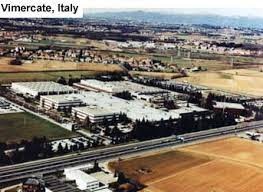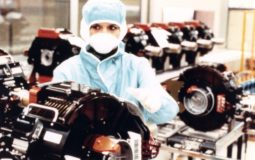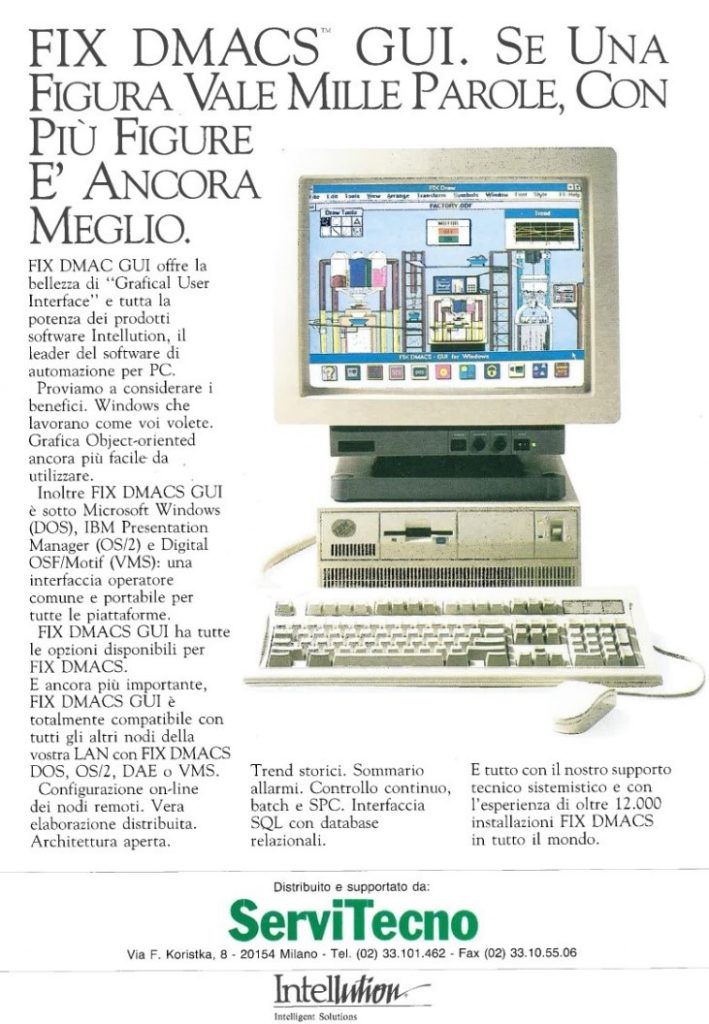In the spring of 2021 iFix celebrates an important birthday: 35 years since the first installations in Italy.
ServiTecno in fact began in the mid-80s the sale, distribution and support in Italy of the software product family of the then Intellution, later acquired by General Electric at the beginning of this millennium.
Among the first applications of a certain consistency, the one in IBM Italy, in the 80s and 90s, came to mind, market leader in the production of large Mainframe computers, but also in the mini-systems used by companies of all sizes and SMEs in Italy. Back then, before the arrival of PCs, networks and then network servers on the market in the 90s, the architecture of business management systems (mainly accounting, inventory control and bill of materials) was based on a " CPU" or "central unit" and "dumb terminals" connected via twisted pair, for definitely challenging investments.

Former IBM plant in Vimercate
The IBM plant in Vimercate (on the outskirts of Milan) was built in 1966 at the end of the Milan east ring road. A land of 287 square meters was chosen, 110 covered by buildings and warehouses to move the historic Milanese IBM headquarters in via Tolmezzo which had become insufficient.
In the golden years at IBM in Vimercate, 3500 people worked, of which over 1600 in production. There was a large computing center, the production of CPUs and electronic boards, and one of the largest "white rooms" in Europe where disks and other special components were assembled for the best-selling IBM systems of the time, such as the IBM Series /1, S/34-36-38 and AS/400, some still active and functioning today. The plant was later sold when IBM moved production to Ireland in the early 2000s.
The Fix 2.0 installed at IBM in 1986-87
In 1986, IBM Italia decided to make a series of investments to optimize production and the following summer, it began installing an industrial automation project for the management of facilities inside the IBM Italia production plant in Vimercate (MI).
The installation of various PLCs, sensors and cameras has generated an integrated control system in the Control Room of all the special systems present in the plant, according to the dictates of the CIM pyramid (Computer Integrated Manufacturing) also supported by IBM on the industrial market.
In particular, thanks to Intellution's The Fix software (at the time version 2.0, with DOS operating system on PC) the energy distribution from the 130KV to 380-220 Volts electrical substation was controlled in the 7 electrical substations distributed throughout the plant. This plant was very "energy-intensive": over 9 MegaWatts of power absorbed by the national electricity grid, equal to what a medium-sized city with a few tens of thousands of inhabitants then consumed.
Thanks to the already advanced graphics integrated in the HMI of The Fix (GUI or Graphical User Interface) it was possible to display on the color monitors of the PCs (at the time with a resolution of only 640×480 pixels) the status of the low and medium voltage electrical switches , of the meters and the management of the same both from the Control Room and from the electrical substations themselves as well as the verification of energy consumption and the detection of any alarms and anomalies, allowing optimal management of consumption and through careful management substantial savings in terms of costs of power.
The Fix was installed on the first types of bus Industrial PCs produced by IBM with rack mounting and specific for industrial environments. An Industrial PC was provided with The Fix in each of the 7 electrical substations, connected to PLC/micro Analog Devices and other specific devices for managing the electrical cabinets. All the cabins were connected on a network ring with "Token-Ring" technology, at the time one of the most secure performing network technologies on the market, also promoted by IBM. All the cabins were certified and communicated with a further PC station with The Fix in a constantly manned control room, where data and alarms were conveyed from the entire system. It was one of the first The Fix installations in Italy made up of different systems connected to each other and it is no coincidence that the IBM plant in Vimercate was chosen precisely because of the advanced production technologies present at that time.
“The Fix already had considerable merits and ease of programming, making it possible to create synoptics that could be easily interpreted by the operators, easy to read and intuitively controlled from the consoles, users enabled to use The Fix were managed hierarchically so that their operations were related to their degree of intervention on the systems.” Remember Alberto costa, then in IBM manager and system administrator.
Thanks to this first industrial automation project, IBM then obtained the contract in 1991 for an integrated control project (Building Management) of the facilities in the then-constructed Alitalia Headquarters at Magliana in Rome, where the FIX version was proposed and used DMACS for OS/2, which had just been released in a distributed and networked configuration (DMACS stood for Distributed Manufacturing Automation Control Software) to make the most of the potential of IBM's 2-bit multitasking OS/32 operating system, forerunner of the 32 and 64 bit versions for MS Windows.
In conclusion
1986 years have passed since 35, which have seen tens of thousands of installations in Italy of The Fix, FIX DMACS, and then GE Digital iFix: still today one of the most powerful and reliable software solutions for all applications where it is required an HMI/SCADA for stand-alone and distributed applications capable of managing even large volumes of data and information necessary for the optimal management of machinery and plants in industry as in utilities.
And still today, as then, iFix is distributed and supported in Italy by ServiTecno.
